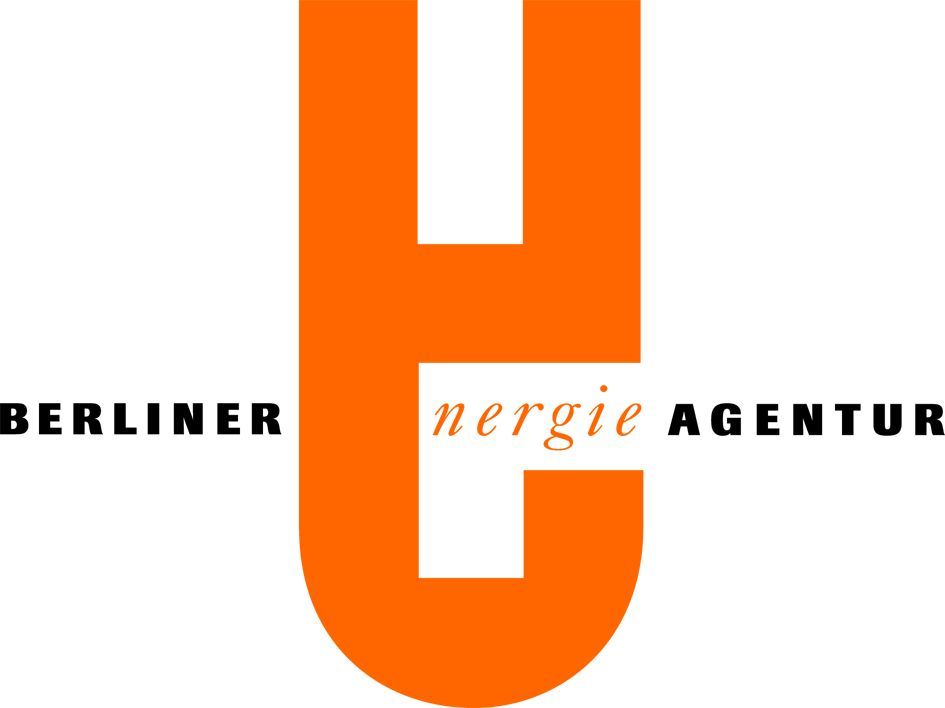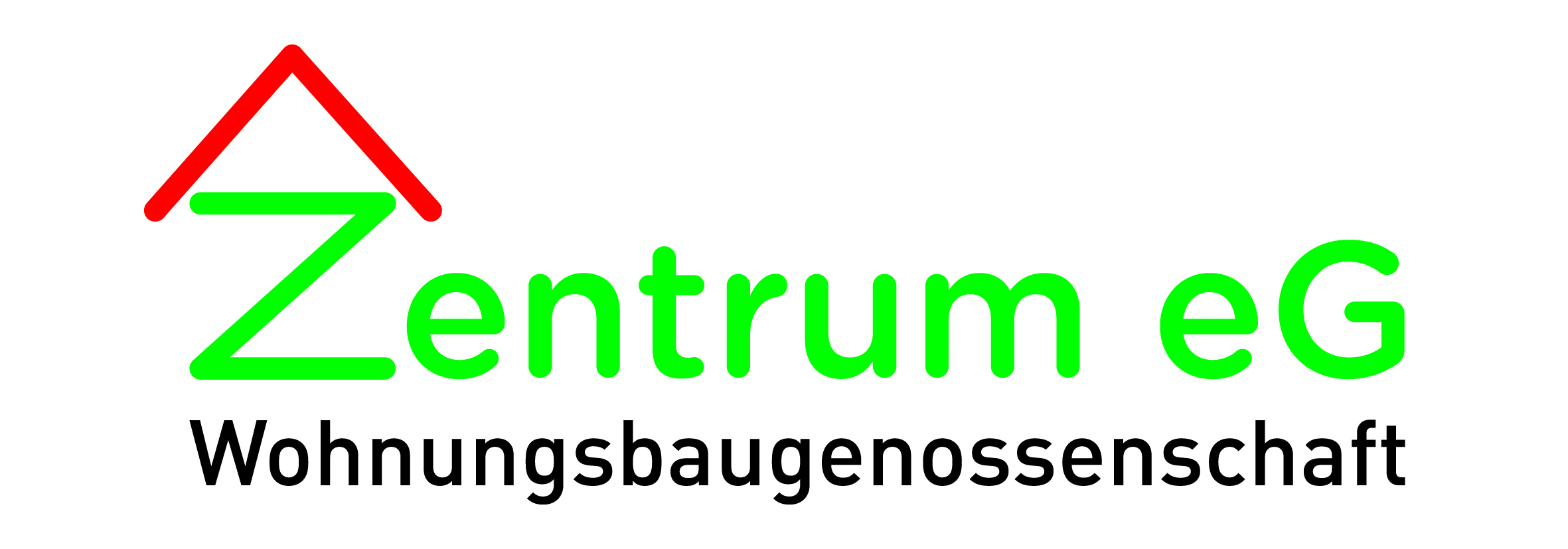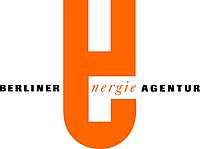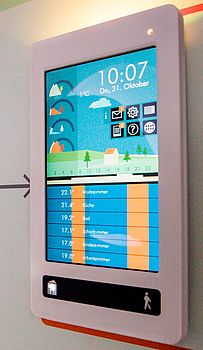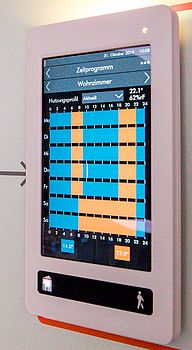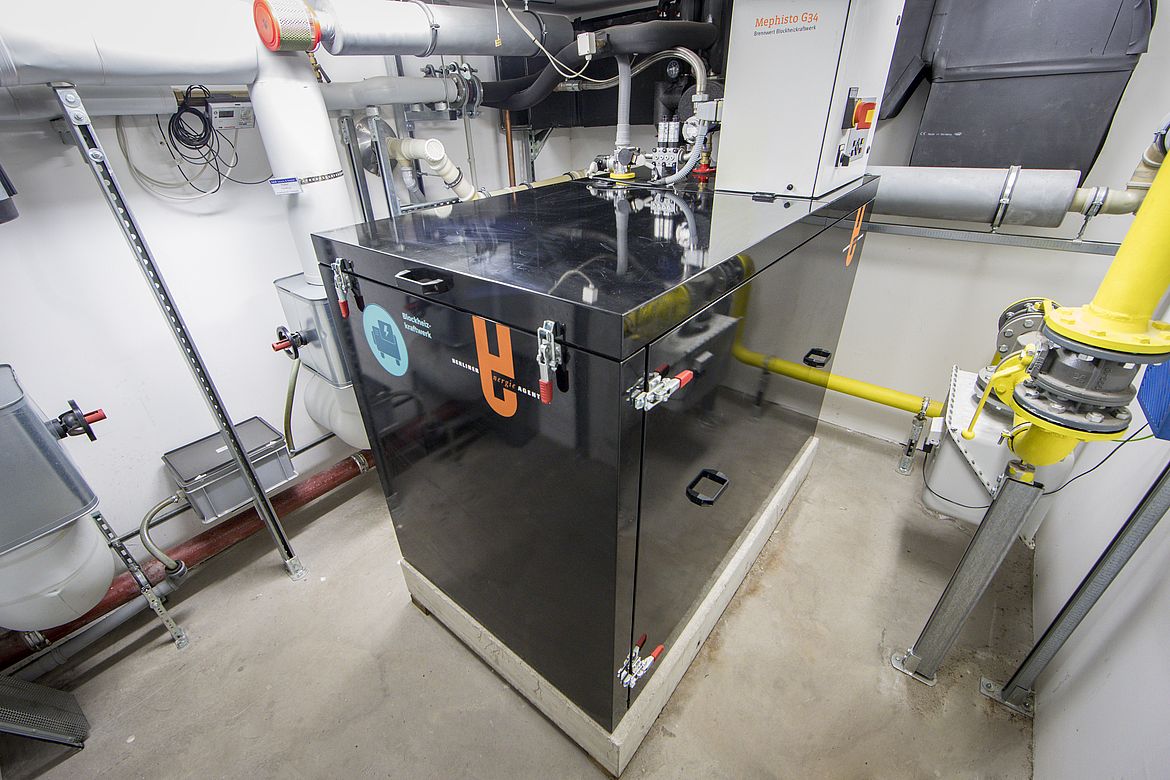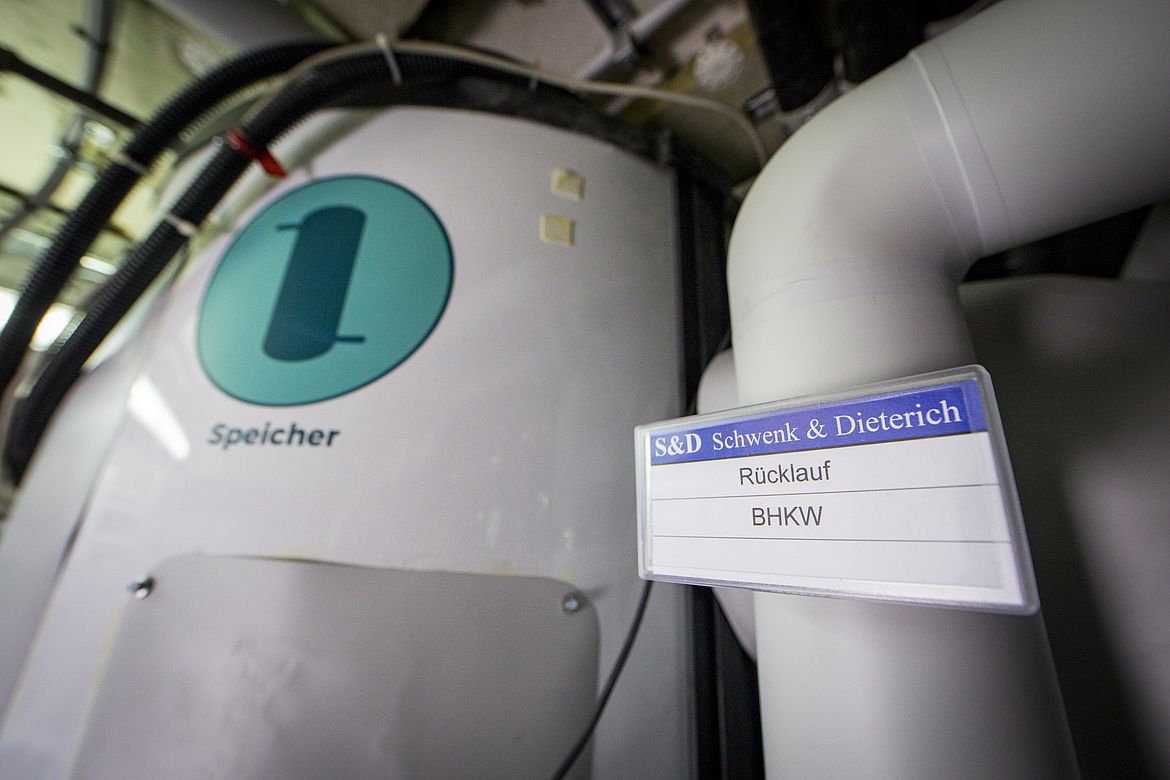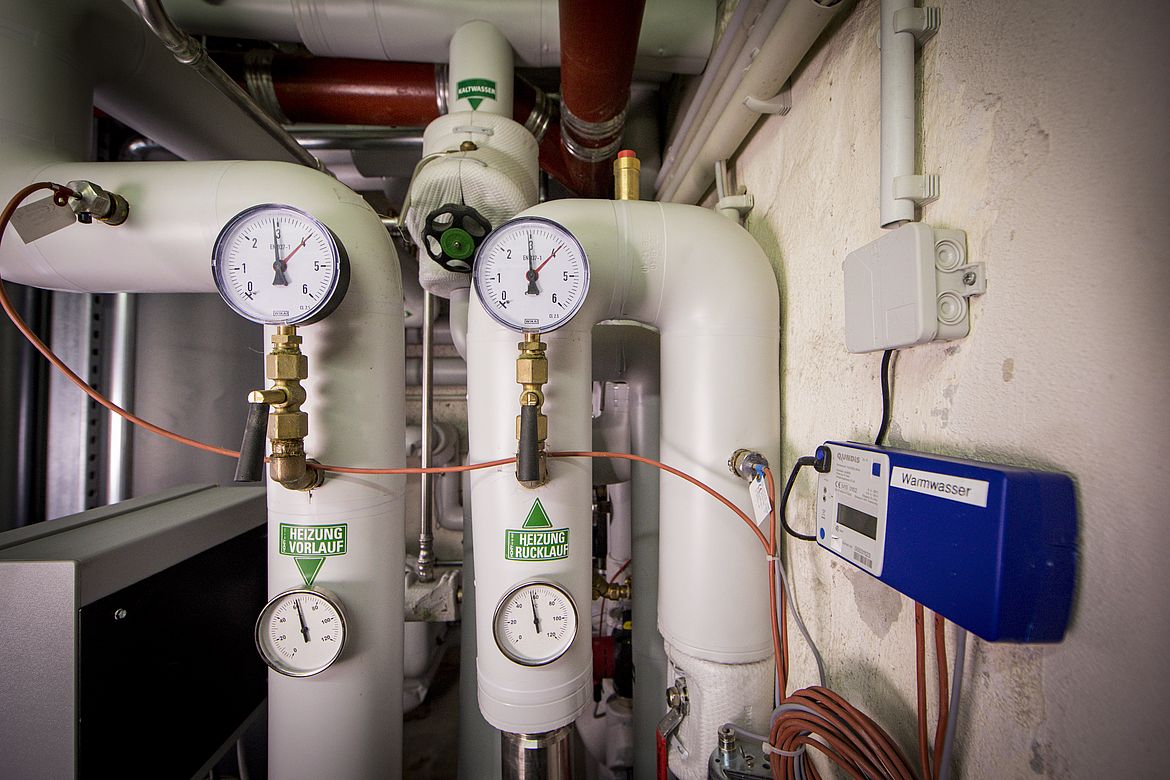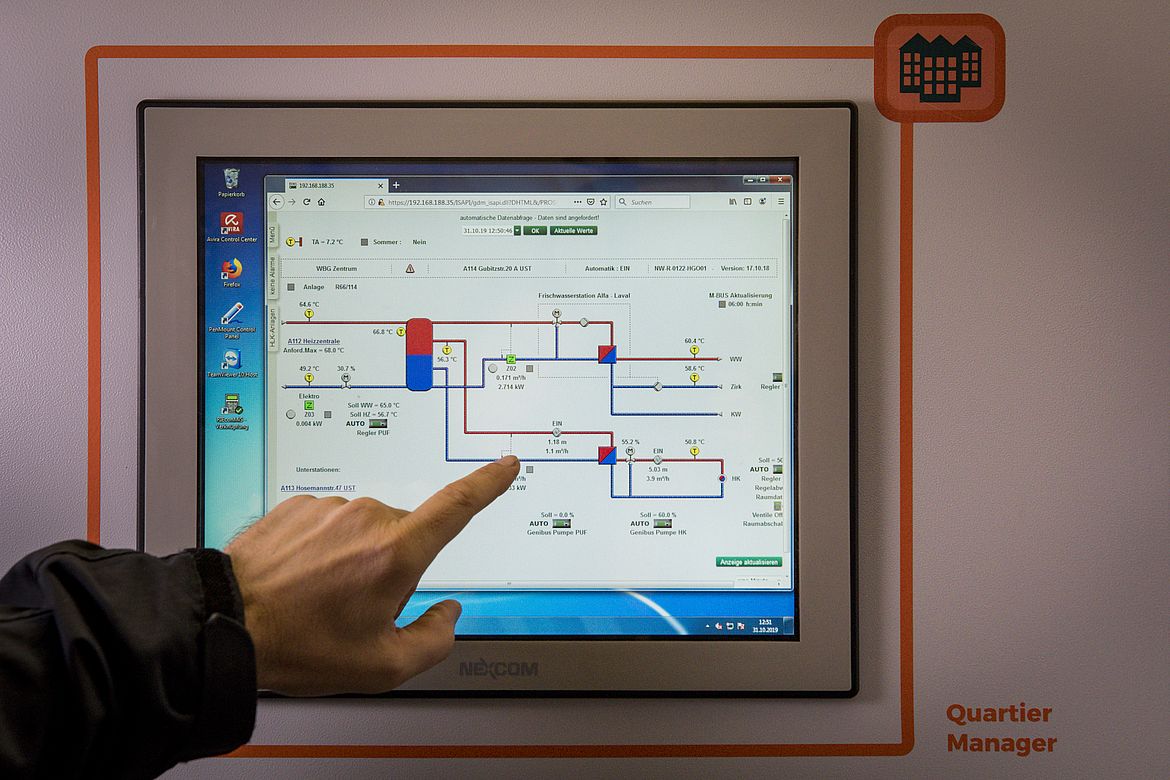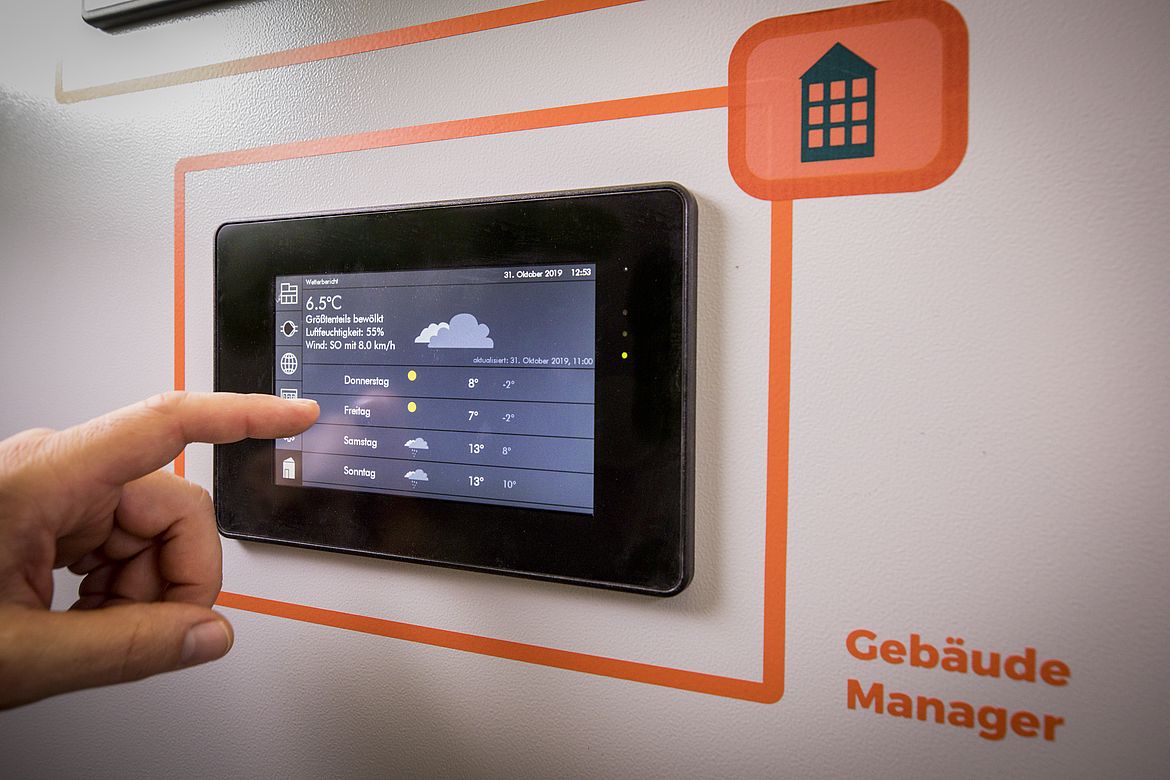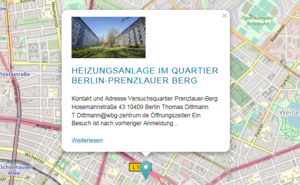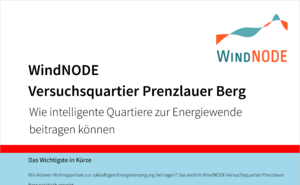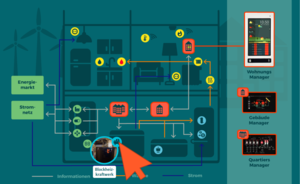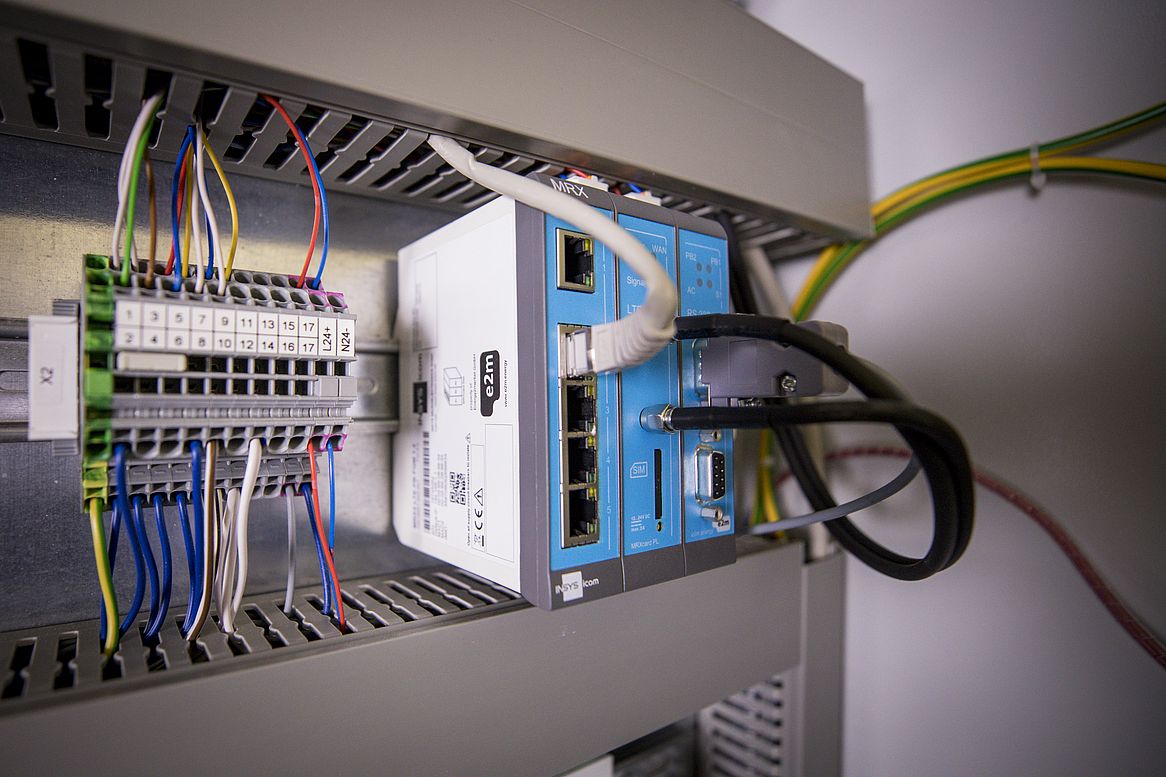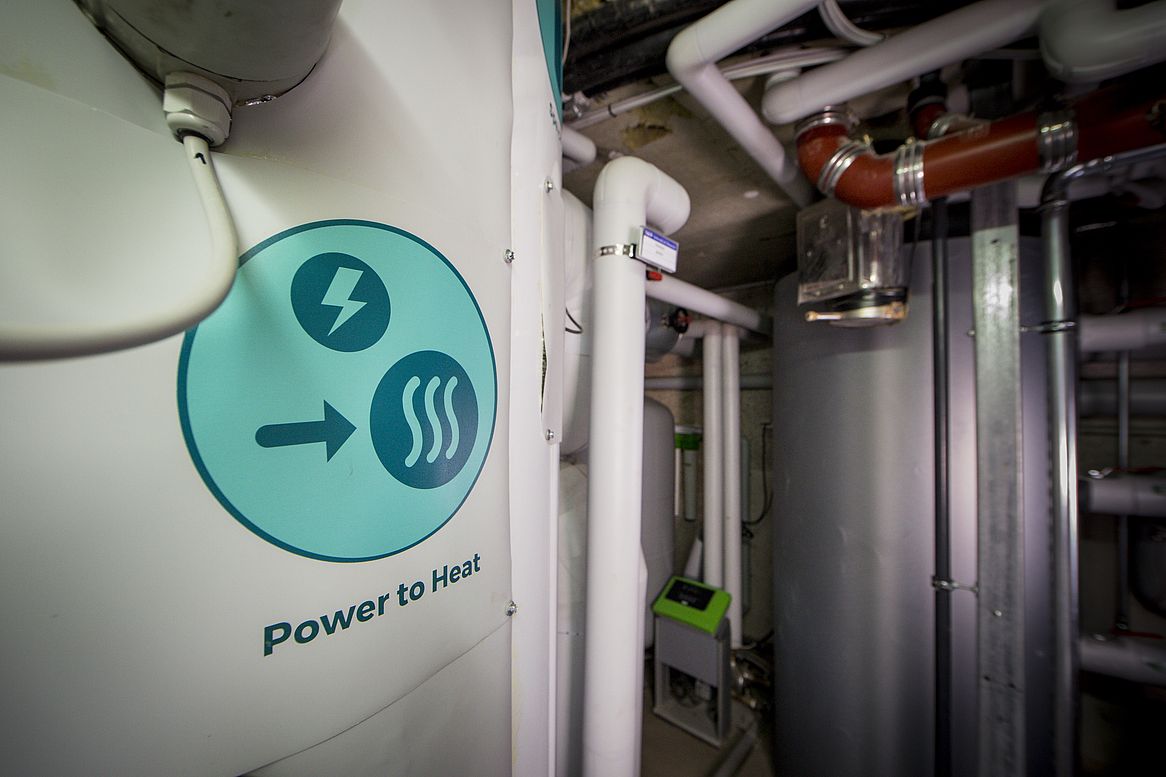Smart building and Power-to-Heat in the conventional building envelope
Reduced energy consumption and flexible electric heating: the future of the energy transition has already started here, in a city quarter from the 1960s, of all places. Incidentally, the WindNODE project shows how the CO2 targets of the building industry for 2030 can also be achieved at a favourable cost to the consumer.
‘This is an absolute flagship project.’ The low-ceiling cellar space in the Berlin district of Prenzlauer Berg is evidently too small for Manfred Riedel’s enthusiasm. ‘Here, we have installed state-of-the-art smart building technology in traditional residential buildings and as a result are saving 24 percent in heating energy without resorting to overpriced thermal insulation,’ says the engineer victoriously. Wohnungsbaugenossenschaft Zentrum eG invested around 25 euros per square metre, whilst maintaining the heating expenses
included in the rent stable. To economise the same amount of CO2 with insulation, the investments would have been three times as high.
Having said that, Riedel claims, ‘the small local heating grid of the quarter can now also be heated electronically when the price on the power exchanges drops due to an oversupply of electricity from renewable sources, or, when cheap solar power is available from the future rooftop panels.
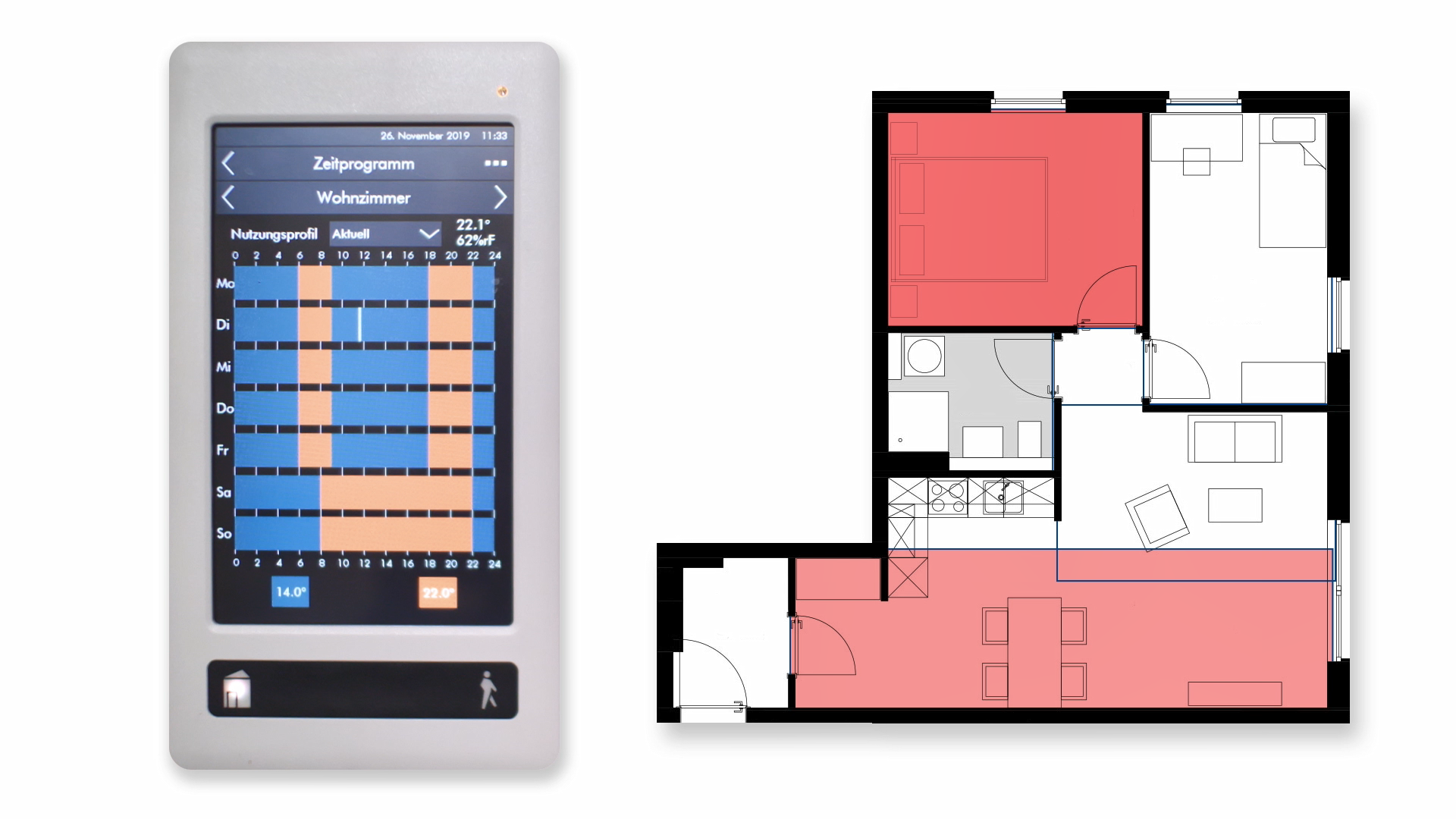
▶ Play
The YouTube video will only load and play after clicking. By clicking the video you agree to Google's Privacy Policy.
Self-learning home manager
Smart building, self-sufficiency and sector coupling: the heating cellar at 43 Hosemannstrasse in Prenzlauer Berg is over-run with technology. To give an example of the extent of this scale, eight immersion heaters issue from two large boilers in just one of the rooms. From here, cheaper wind power can be converted into hot water when necessary. In the next room, a combined heat and power (CHP) unit is running smoothly. It is responsible for the distributed heat supply. A complex web of pipes occupies the ceiling, connecting the six buildings of the quarter to a local heating grid.
Manfred Riedel’s area of expertise is the building automation technology installed in each of these 224 homes: temperature sensors, electric thermostat valves, motion sensors and the control displays enable each tenant to individually regulate the desired temperature for each room:
From 6 to 8 am, the bathroom should be cosy at the optimum 23 degrees Celsius.
In the kitchen preferably 20 degrees Celsius from 7 to 9.
And in the bedroom, 17 degrees Celsius at night, or no heating at all.
When the tenants leave the property and go about their day, the digital home manager, developed by Riedel Automatisierungstechnik, adjusts the heat supply, accordingly, thus lowering the temperature. Just before the tenants return, the system begins to gradually heat the home. What is most impressive is that the home manager, a self-learning system, autonomously determines how much time is required to heat the homes. In addition to the outside temperature, it also takes into consideration external factors such as the weather forecast and therefore knows that, for example, poor weather and a cold front have been forecast for the afternoon.
Energy consumption lowered by 24 percent in addition to renovation
Manfred Riedel runs his finger across the touch display in the cellar, an exact replica of the screens that are installed in the 224 homes. ‘Many tenants set their heating times painstakingly precise, allowing them to save up to 30 percent in heat energy,’ says Riedel as he summarises their experiences from the operation so far. As a result of this, consumers directly benefit from the savings. Additionally, the tenants can consistently monitor how much heat and electricity they consume, which in turn encourages smart consumption.
And what if a tenant doesn’t buy into this, or the elderly consumer does not fully understand the technology? ‘No problem,’ says Riedel. ‘Thanks to the motion sensors in each room, the home system is able to detect regular movement in each room and therefore is able to adjust the room temperature accordingly.’
The quarter in the Hosemannstrasse was renovated in the 1990s in accordance with the Thermal Insulation Ordinance of 1995. The building envelope was insulated, and the windows were replaced. By implementing the new control technology, the energy consumption dropped an additional 24 percent, down to the level of
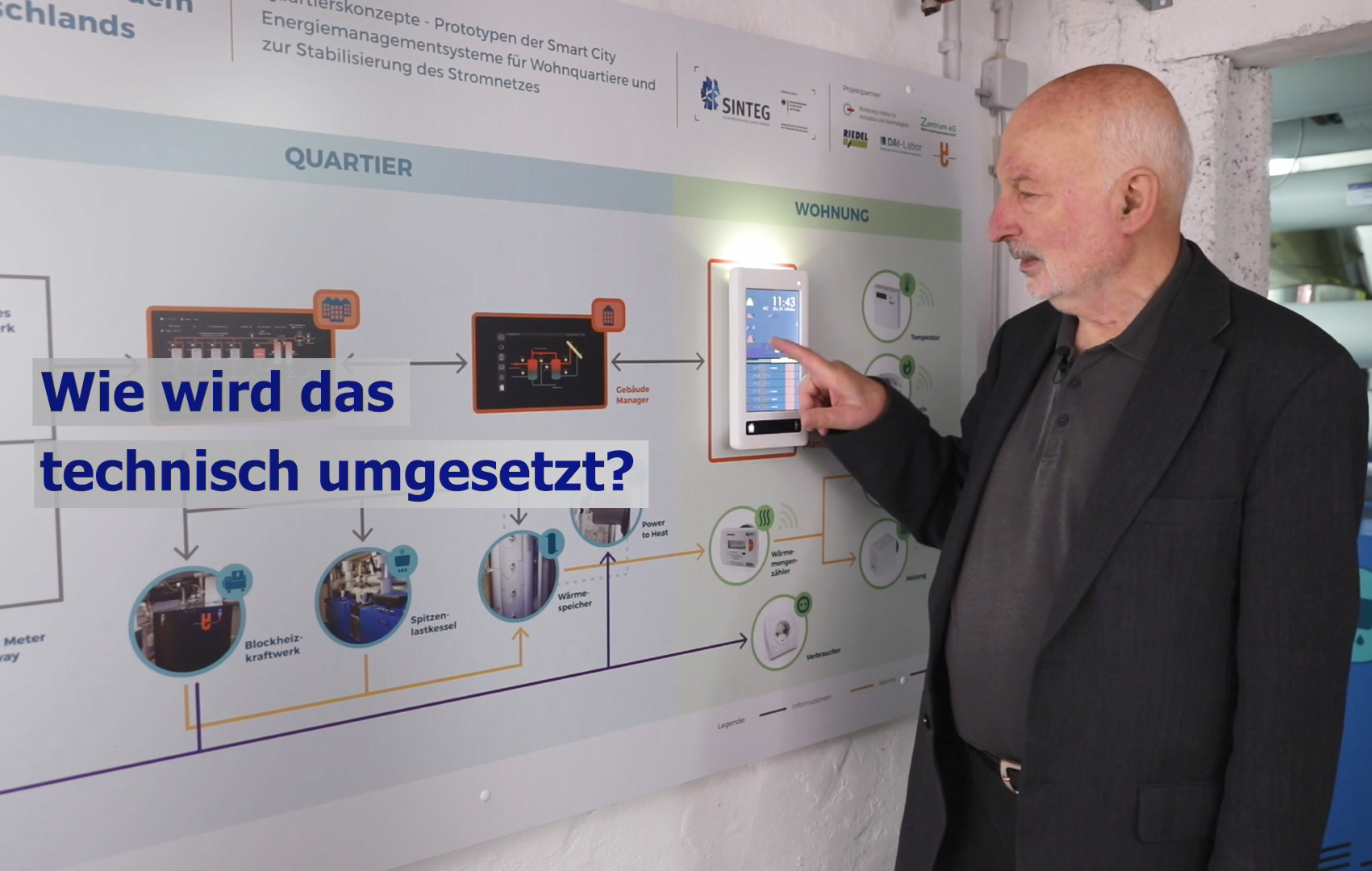
▶ Play
The YouTube video will only load and play after clicking. By clicking the video, you agree to Google's Privacy Policy.
Connectivity in the entire quarter
Albeit sounding a little like science fiction, it is actually a matter of the latest technology combined with clever IT: the home manager first aggregates the sensor data and then sends the necessary control signals to the remote-controlled thermostat valves in the individual rooms. Simple smart-home systems already featured these solutions; however, Riedel claims that his system is not limited to individual homes.
‘A key point in this project is the connectivity of heat management in the entire quarter,’ Severin Beucker explains. The founder of Berlin’s Borderstep Institute for Innovation and Sustainability supported the science behind the WindNODE project.
During the day, if the system detects that little heat will be required in the home in the coming hours, it also lowers the flow temperature at which the CHP unit feeds the water into the heating circuit for the 224 homes spread across six buildings. ‘In many cases, the central heating simply continues to work, pumping hot water into the circuit and heating walls and cellars while the homes no longer need to be heated,’ says Beucker. He adds, ‘however, here we are dealing with class A building automation and adaptive management. The requirements for such a system are described in DIN EN 15232 and are cutting edge,’ explains Beucker.
Cheap electricity for heating and tenants
The software-controlled heat supply of the quarter is closely linked to the power system. The CHP unit, the operation of which is contracted out to the Berliner Energieagentur (BEA), has initially been conceived in the classical manner to meet the demand of the quarter’s current expectations. The simultaneously generated electricity is supplied to the tenants and is 2-3 cents per kWh cheaper than the average electricity rate. ‘For the housing association, it is important that the tenants also benefit from the energy transition,’ says Riedel.
On a different display in the cellar, he shows that the current electricity generation by the CHP unit is shown as a consistent orange line. A blue line interchanges up and down around this constant value: the electricity demand of the 224 renting parties. ‘The difference is indicated by the third line, which is the current that is additionally drawn from the grid,’ says Riedel.
This coupling consumption of electricity, generation by the CHP unit and external procurement is the second key subject of the WindNODE sub-project: it is a question of preparing even the small-scale electricity producers and consumers for a power grid that will offer even higher shares of renewable energy. Available renewable electricity should be used instead of curtailing wind turbines in the event of an oversupply.
In the Hosemannstrasse, the joint test with energy trader Energy to Market (e2m) is therefore being conducted to determine how the installations in the quarter can be managed in accordance with the electricity that is available from renewable sources at that time. To achieve this aim, e2m receives information about the heat and electricity demand in the quarter and, considering this data, it can then determine the optimal operation of the installations, depending on the current electricity costs. In the future, it will be possible to cut back the gas-operated CHP unit’s output when the electricity prices are low and convert to the electric immersion heaters that are installed in the boilers of the heating circuit.
On the other hand, the CHP unit can then feed electricity into the grid, when the electricity prices are high, for instance, because there is only little renewable energy available. Beucker commented, ‘We need such flexible consumers and storage units in an energy system in which the main producers of electricity will be wind turbines and solar installations.
Coupled with the German Institute for Standardization (Deutsche Institut für Normung, DIN), we are working on a standard (the DIN SPEC 91410-2) that will make it possible to identify and use such flexibilities in urban quarters.’
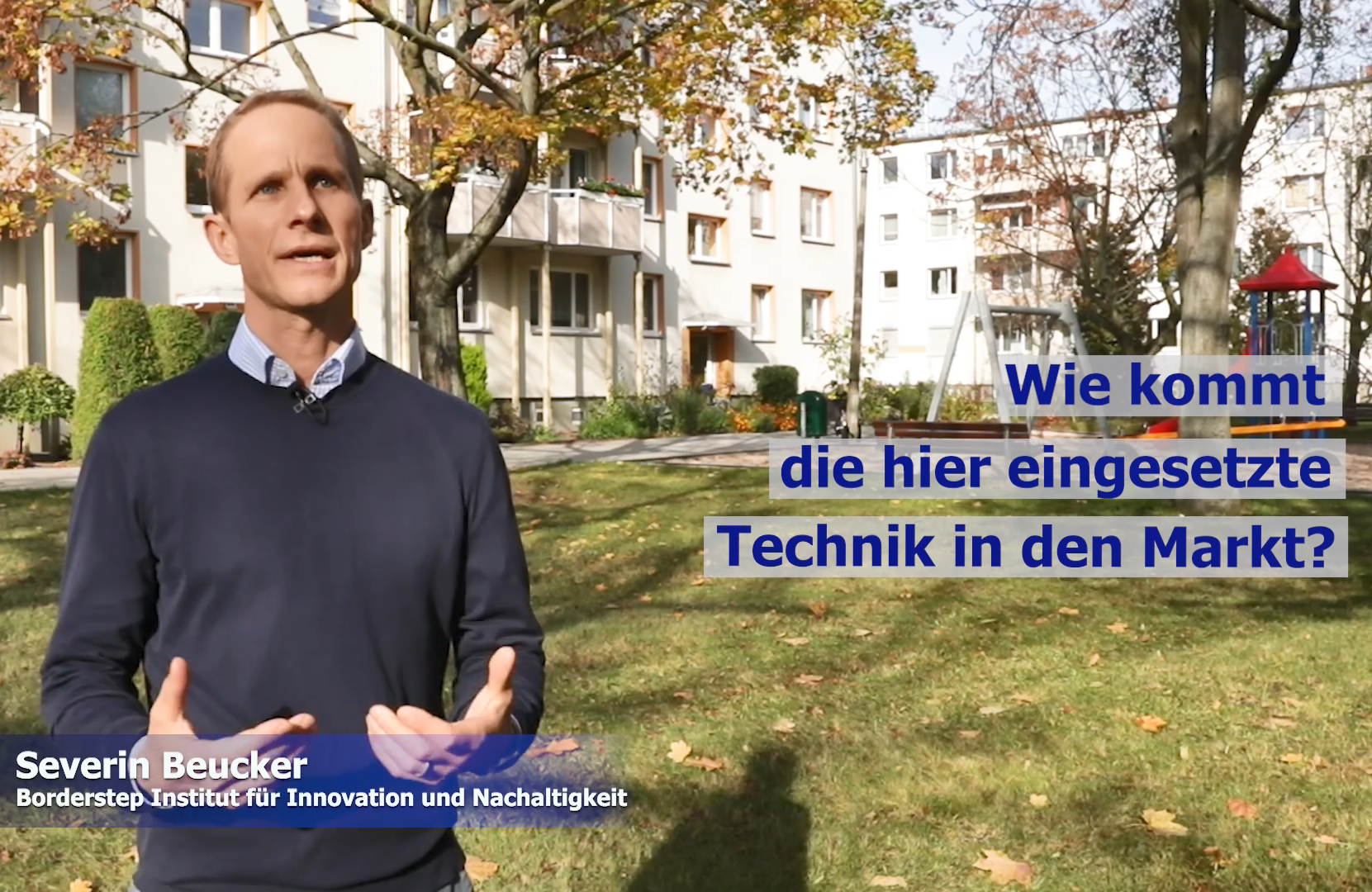
▶ Play
The YouTube video will only load and play after clicking. By clicking the video you agree to Google's Privacy Policy.
‘Such a standard,’ says Beucker, ‘enables us to help design future markets for the use of flexibilities. This makes flexibility from residential quarters useful, whicle the tenants benefit from the energy transition.’ He goes on to say, ‘Although the building sector is responsible for a large part of the energy consumption and has many opportunities for sector coupling (e.g. conversion of electricity into heat), this notion has not yet firmly established itself in the energy industry’s awareness.’
Particularly in the building sector, compliance with standards is essential in order to gain acceptance by companies and customers. Since there are no existing standards so far, Beucker takes the initiative. As a positive side effect of the DIN SPEC, the exchange with standardization has already made the progress to an industry-known standard tangible. It is expected that the cooperation with DIN contributes to making the applied technology state-of-the-art and bringing it to the market.
Energy price and investor-user dilemma
The IT infrastructure is currently undergoing an endurance test in the scope of the WindNODE project. The DAI Laboratory of the TU Berlin is using the data from the quarter and improved prognoses to identify the areas where we can cut costs. ‘We have no doubt that the technology works,’ says Manfred Riegel with complete confidence.
The framework, however, could pose some issues. In order for the switchover from the CHP unit to the immersion heaters to be financially worthwhile, the energy traders must first offer a wider range of electricity prices.
What’s more: the prices for heat generated from gas in the CHP unit (around 6 to 7 cents per kWh) along with electricity from the own installations (solar: 5 to 7 cents per kWh) have in the meantime reached the same level. Having said that, because grid fees, EEG surcharges and taxes are also added to the price of electricity generation, Power-to-Heat currently makes little sense from an economic point of view.
‘Add to this that homeowners have no economic incentive to save energy. They have to bear the investment while only the tenants’ benefit,’ says Riedel. In order to transfer the success from the quarter in the Hosemannstrasse to the classic property sector, technical specifications and standards for the housing industry are just as necessary as state support measures for energy-oriented renovation.
From the moment we reach such a status, Riedel explains, large solar panels could be installed on the rooftops of quarters such as the Hosemannstrasse to provide the tenants with highly cost-effective energy (and heat). The heat supply to Berlin’s homes could also act as a buffer store, where surplus electricity is stored as heat. A win-win situation for tenants and energy transition.
Six Questions to...
Annegret-Claudine Agricola: The Berliner Energieagentur has been providing energy services in the city since its foundation. We are currently operating some 100 combined heat and power (CHP) units and are supplying tenants in the Hosemannstrasse with heat and electricity from the installation. Here, the tenants pay less than 25 cents per kilowatt-hour for the electricity. This gives the tenants an average saving of 2-3 cents per kilowatt compared to that of private paying customers.
The CHP is integrated into the energy system via the e2m electricity trading platform. In this scope, we are researching how such installations can be controlled externally and integrated into a virtual power plant. Given all runs smoothly, in theory, it should be possible to install/construct hundreds more of CHP units, which in turn would allow for flexible potential being available to the power system.
Here, we are developing one of the solutions that we will need in a future power system with very high shares of fluctuating generation. The more volatile the electricity generated from wind and sun, the more freedom other producers, such as the operators of a CHP unit, must have to compensate. In this instance, we are specifically targeting residential quarters.
The share of distributed generation in residential quarters is expanding both the CHP units and solar installation. At the same time, there is often a hot water system that can be used to convert electricity into heat in the event of an oversupply by means of heating elements, to store the energy as well as help maintain the balance of the power grid. In the future, we will see the introduction of electric vehicles, whose batteries can also be used within the power grid as a flexibility potential. The WindNODE project in the Hosemannstrasse shows how this can work in principle.
We need different framework conditions. So far, there are only a few electricity supplies on the market where the electricity price is solely dependent on the current consumption of electricity in the grid and the generation of electricity from renewable sources. These offers will soon evidently increase in number, however. Naturally, one must also consider that at 34 kilowatts, the electrical flexibility potential of our CHP unit is relatively small. Only by networking as many of these small generating units as possible can their flexibility potential be used widely within the power grid. It’s for this reason that it’s essential that we are collaborating with a virtual power plant operator.
That is the next point. Different energy sources acquire a different cost. Whereas the duties and taxes on gas are manageable, those on electricity are many times the actual cost of generation.
This makes heat from electricity, and therefore also from wind power, much more expensive today than heat from the CHP unit or other heat sources. In order to make Power-to-Heat technology using renewable energy productive in practice, a number of issues first need to be addressed.

